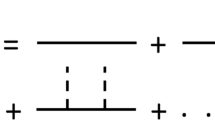Abstract
Steady-state flow towards a well through a thin porous deformable two-layer reservoir with allowance for deformation of the surrounding rocks is investigated. The permeability of the reservoir is considered to be a function of the displacements of its top and bottom. The effect of deformation on the well production indicators is studied. The results obtained agree qualitatively with the data of full-scale experiments. Earlier, in [1–5], in considering the self-consistent processes of flow through porous media and their deformation attention was concentrated on the analysis of the stress-strain state of the rocks and reservoir and on unsteady problems within the framework of the nonlocally elastic flow regime.
Similar content being viewed by others
References
V. M. Entov and T. A. Malakhova, “Variation of stress-strain state of rocks with change in pressure in a fluid-saturated reservoir,”Izv. Akad. Nauk SSSR, Mekh. Tverd. Tela, No. 6, 53 (1974).
V. N. Nikolaevskii and T. K. Ramazanov, “Stress-strain state of rock mass in the nonlocally elastic regime of flow through a porous reservoir,”Izv. Akad. Nauk SSSR, Mekh. Tverd. Tela, No. 3, 138 (1977).
V. N. Nikolaevskii and T. K. Ramazanov, “Stress-strain state of a porous reservoir with allowance for fluid flow,”Izv. Sib. Otd. Akad. Nauk SSSR, FTPRPI, No. 5, 37 (1982).
A. F. Zazovskii, “Stressed state of a fluid-saturated reservoir in the neighborhood of an operating well,”Izv. Akad. Nauk SSSR, Mekh. Tverd. Tela, No. 3, 111 (1980).
V. N. Nikolaevskii and T. K. Ramazanov, “Stress-strain state of a reservoir and pressure recovery in a well,” in:Mechanics of a Deformable Body. Strength and Viscoelastoplasticity [in Russian], Nauka, Moscow (1986), P. 94.
Ya. S. Uflyand,Integral Transforms in Problems of Elasticity Theory [in Russian], Nauka, Moscow (1967).
D. S. Kuznetsov,Special Functions [in Russian] Vyssh. Shkola, Moscow (1965).
V. M. Dobrynin,Deformation and Changes in the Physical Properties of Oil and Gas Reservoirs [in Russian], Nedra, Moscow (1970).
T. D. Golf-Rakht,Fundamentals of Fractured Reservoir Engineering, Elsevier Sci. Publ. Comp., Amsterdam, Oxford, New York (1982).
N. N. Nepremenov,Three-Dimensional Analysis of Oil Recovery from Cooled Reservoirs [in Russian], Izd-vo Kazan. Univ., Kazan' (1978).
N. G. Zainullin, R. N. Diyashev, A. M. Rudakov, and K. G. Mazitov, “Justification of optimal bottomhole pressure in carbonate reservoir development,” in:Upgrading of Oil Field Development Efficiency, Issue 62 [in Russian], Tr. TatNIPIneft' (1988), P. 121.
Additional information
Kazan'. Translated from Izvestiya Rossiiskoi Akademii Nauk, Mekhanika Zhidkosti i Gaza, No. 1, pp. 86–93, January–February, 1995.
Rights and permissions
About this article
Cite this article
Diyashev, I.R., Konyukhov, V.M., Kosterin, A.B. et al. Well production indicators in a deformable reservoir interacting with rocks. Fluid Dyn 30, 70–76 (1995). https://doi.org/10.1007/BF02029929
Received:
Issue Date:
DOI: https://doi.org/10.1007/BF02029929




